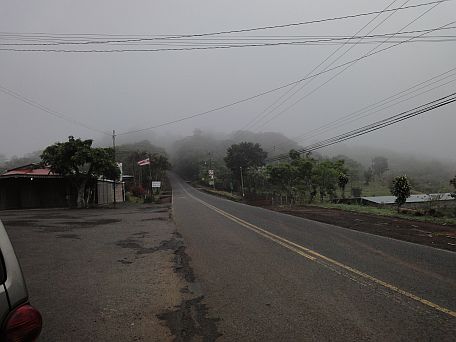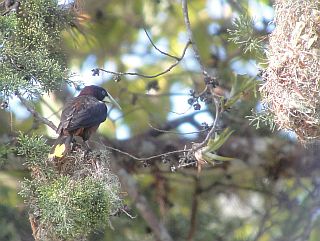I normally don’t get the chance to go birding on Mondays. The morning is typically reserved for bringing my daughter to the babysitter, and the rest of the day sees me sitting in front of the computer. I hear TKs and Rufous-collared Sparrows in the early part of the day, envy the freedom of Red-billed Pigeons, White-winged Doves, Blue and white Swallows, and Blue-gray Tanagers as I drive through narrow, busy streets, and always wish I was exploring luscious rainforests on the other side of the mountains. The GPS insists that they are so close (20 miles in a straight line) but the dramatically upheaved topography and my schedule ensure that the green havens are a bit too far for a quick visit.
Unless I am guiding (and I give a thousand thanks to everyone I have guided), my birding in Costa Rica is usually limited to the weekend. This past Monday was the happy exception as I was tasked with delivering binoculars to a young guide who lives just outside of La Fortuna. He had been waiting months for those binoculars because of the difficulties associated with him coming up to the Central Valley and me driving over to the Arenal area. I didn’t want to send them with the local mail service because I frankly didn’t want to risk losing that precious cargo, or having them arrive a month later. I didn’t have to bring Miranda to the babysitter in the morning because she spent the night there on Sunday (and surely enjoyed it because she got to hang out with her Madrina or Godmother), so Monday was the day to drive to La Fortuna AND bird along the way!
I left just before the break of dawn- one of the best times for driving because of the dearth of traffic- and headed west on the highway towards the small city of San Ramon. I drove with the windows down to listen for birds as I coasted down towards the airport but the only things I heard were Great-tailed Grackles, TKs, Grayish Saltators, Rufous-collared Sparrows, and Blue-gray Tanagers. I am always on the listen for Prevost’s Ground-Sparrow to find more sites for this species and make a roughshod attempt at assessing its habitat needs, but no such luck in hearing any on Monday.
The windows went back up once I reached the highway and traffic picked up. Even at five a.m., trucks were barreling along and people were waiting for buses. I passed the sugarcane fields and patchy moist forests around Grecia and Palmares, and took the turn off to San Ramon before the highway starts its descent to Puntarenas and the Pacific lowlands. As I drove through town, overcast skies made me wonder if rain would foil my attempts at getting bird recordings and pictures. Things didn’t look any better as I made my way over the low pass to the Caribbean Slope.

There’s fog in them there hills…
The drive over the pass near San Ramon is typically a misty trip but on Monday the fog was a curtain of damp, dingy cotton. I slowly made my way along the road and wondered where the bottom of the cloud was located. The songs of Eastern Meadowlarks and Bronzed Cowbirds issued from the ether-like surroundings and were testament to the tragic conversion of forest to pasture that occurred decades before any protected areas in Costa Rica even existed as a concept. When I heard the hurried songs of Mountain Robins and cheerful snippets of Slate-throated Redstarts, I knew that I had once again reached forested areas, and not long after, the fog lifted to reveal dripping cloud forest and light rain near the Nectandra Institute and the San Luis Canopy.
The hurried song of a Mountain Robin
I was tempted to make a stop at the San Luis Canopy to scan a forested hillside for Bare-necked Umbrellabird and Lovely Cotinga, but just drove on past because I wanted to maximize my time along the road to Manuel Brenes Reserve. I reached this excellent middle elevation site 10 minutes later and although it was still raining, the precipitation was exactly how you want it to be- enough to fool the birds into thinking that it’s early morning but not so much that you can’t watch them. I don’t expect that the birds are actually fooled, but when the weather is like this, they sure act as if it’s 7 a.m. A downside is that it’s not conducive for bird photography so you won’t see many images in this post. I guess you will just have to go there yourself (I can guide you) to see things like Brown-billed Scythebill, Purplish-backed Quail-Dove, Rufous-browed Tyrannulet, some sweet antbirds (aren’t they always?), and a bunch of tanagers.

Fog or light rain in tropical forests = awesome birding!
Upon arrival, I had the usual suite of aquatic and second growth species that I get at this site:
Least Grebe, Northern Jacana, calling White-throated Crakes, Ringed Kingfisher, Red-billed Pigeon, flyovers of White-crowned Parrots, Slaty Spinetail, Tropical Pewee, Cinnamon Becard, and Montezuma Oropendolas to name a few.
Just up the hill, things got exciting as soon as I stepped out of the car when a male Black-crested Coquette buzzed around a low bush with small yellow flowers. He got chased off by a Violet-crowned Woodnymph, and before I knew it, I had a perched Blue-throated Goldentail in my bins. A quick look around revealed some of the best hummingbird activity I have seen on this road. Without feeders, the flowering Ingas and bushes turned up 8 species of hummingbirds including Brown Violetear, Violet-headed Hummingbird, and a few Steely-vented Hummingbirds! This is the second time I have seen this Pacific Slope species happily sucking nectar from flowers fed by waters that rush down to the Caribbean Sea.
While attempting to ID hummingbird silhouettes (another downside of birding in misty conditions), Black-throated and Stripe-breasted Wrens sang, Yellow-olive Flycatcher was being too hyperactive for photos, and Thicket Antpitta called from its usual inpenetrable haunts. I slowly made my along the road and recorded the voices of a good bunch of birds. Some of these were: Long-billed Gnatwren, Dusky Antbird, Keel-billed Toucan, Brown-hooded Parrot, and Black-headed Nightingale-Thrush.
This recording gives you an idea of what it sounds like along the road to Manuel Brenes Reserve (Scale-crested Pygmy-Tyrant, Blue-black Grosbeak, Lesser Greenlet, and Tropical Parula among others): Manuel Brenes Road Medley
While I was capturing the sounds of this little known Costa Rica birding hotspot, I also saw quite a few species including: American Swallow-tailed Kite, Crested Guan, Spotted Woodcreeper, Plain Xenops, Rufous Mourner, Black-faced Grosbeak, Passerini’s, Black and Yellow, White-throated Shrike, Speckled, and Hepatic Tanagers, Scarlet-thighed Dacnis, Russet Antshrike, Tawny-faced Gnatwren, and others.
The only bird I was able to photograph was one of the best. The image isn’t going to provoke any “oohs” or “aahs”, but if you use your imagination (and a field guide), you should be able to identify it as a Blue and Gold Tanager.

Blue and Gold Tanager- uncommon regional endemic often found in this area.
I stayed until ten a.m. or so before heading down the highway to La Fortuna. After meeting and giving the binoculars to Elias (a young guide for the Arenal area with a good handle on the birds there), I should have made my way back to the Central Valley but instead, opted for heading over to Lake Arenal in search of my lifer Keel-billed Motmot. Being short on time and in desperate need of this uncommon species, I chose to broadcast its vocalizations into a few suitable looking spots. I came up empty handed (except for a distant Sulphur-bellied Flycatcher) and liferless but it was worth a shot. If I hadn’t went looking for the motmot, I wouldn’t have gotten my best images of the day:

Displaying male White-collared Manakin.
He only let me get off two shots before rushing back into the undergrowth but both came out pretty nice!
After success with the manakin, I checked out the lake and ended up getting my year Peregrine Falcon instead of any interesting waterbirds. As this site can be good for Plumbeous Kite, I was half expecting the falcon-like shape to be that species but I wasn’t complaining when it turned into an adult Peregrine- an awesome bird to end the day. In all honesty, it wasn’t actually the end of my day but I prefer that happy ending over the subsequent experience of driving through cushion thick fog, pounding rain, and horrendous traffic.














